The Angle-Resolved Photoemission Spectroscopy Market has been forecasted to attain a valuation of USD 93.3 million in 2025, rising to USD 292.5 million by 2035, resulting in an incremental gain of USD 199.1 million, which reflects a 31.9% increase over the forecast decade. A compound annual growth rate (CAGR) of 12.1% is expected to be recorded, indicating a rapid expansion trajectory for the angle-resolved photoemission spectroscopy market.
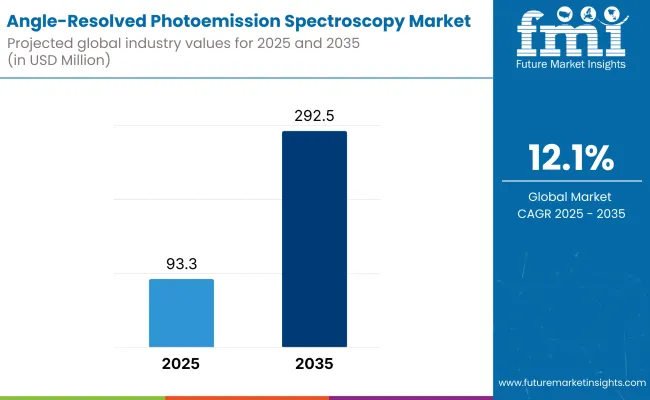
Angle-Resolved Photoemission Spectroscopy Market Key Takeaways
| Metric | Value |
|---|---|
| Market Estimated Value in (2025E) | USD 93.3 million |
| Market Forecast Value in (2035F) | USD 292.5 million |
| Forecast CAGR (2025 to 2035) | 12.1% |
During the first five-year period from 2025 to 2030, the Angle-Resolved Photoemission Spectroscopy (ARPES) market is set to grow from USD 93.3 million to USD 165.2 million, contributing USD 71.9 million, or approximately 36.1% of the total decade growth. This period marks a steady expansion in adoption across university laboratories, semiconductor R&D centers, and synchrotron light source facilities.
ARPES is becoming indispensable for band structure mapping, enabling key advances in topological insulators, 2D materials, and unconventional superconductivity. Laser-based ARPES Systems dominates this period with more than 43.0%. The convergence of ultra-high energy resolution with user-friendly software is making ARPES more accessible, prompting growth even in mid-tier academic institutions and national labs.
Between 2030 and 2035, the market is projected to add USD 127.2 million, as it accelerates toward USD 292.4 million by 2035. This phase is characterized by rapid proliferation of spin-resolved (SARPES) and time-resolved (trARPES) systems, driven by their essential role in quantum computing, spintronics, and ultrafast electronic dynamics research.
Technological progress in cryogenic manipulators, ultra-fast pulsed lasers, and next-gen detectors will define this phase, enabling sub-femtosecond resolution and spin-selective detection at higher throughput. Synchrotron-based ARPES Systems and Lab-based ARPES Systems constitutes around 57.9% by the end of the decade.
Between 2020 and 2024, the ARPES market advanced from USD 48.6 million to USD 83.7 million, transitioning from a synchrotron-dominated research technique to a broader lab-based and tabletop-compatible instrumentation category.
During this foundational phase, key equipment manufacturers collaborated with academic and national research centers to simplify vacuum chamber integration, beamline alignment, and data acquisition workflows. Competitive differentiation focused on instrument modularity and reducing system complexity factors that paved the way for decentralized access in surface science and electronic materials characterization.
Going forward, the ARPES ecosystem is expected to hold a revenue of USD 93.3 million in 2025 and is will likely evolve to incorporate AI-powered spectral analysis, real-time data visualization, and hybrid compatibility with other measurement modalities such as STM and LEED. These innovations aim to reduce the learning curve, expand interdisciplinary usability, and improve throughputmaking ARPES a staple characterization technique in condensed matter physics and electronic materials research.
The growth of the Angle-Resolved Photoemission Spectroscopy (ARPES) Market is reinforced by the unique ability of this technique to directly probe the electronic structure of advanced materials, especially those relevant to quantum computing, superconductivity, and topological insulators. In contrast to conventional spectroscopic tools, ARPES provides momentum-resolved insights into quasiparticle dynamics, band dispersion, and Fermi surface topologymaking it indispensable for next-generation electronic materials research.
Over the last decade, the scope of ARPES has expanded beyond fundamental condensed matter physics. It is now a critical tool in semiconductor R&D, enabling detailed analysis of band alignment, spin-orbit interactions, and interface states at the nanoscale. As materials with non-trivial topological and correlated electron behavior gain prominence in applied physics and device engineering, ARPES is becoming a mandatory characterization technique across leading research institutions and commercial innovation labs.
Another factor driving adoption is the shift from synchrotron-only access to highly capable lab-based ARPES systems. With vendors now offering turnkey platforms that integrate cryogenic manipulators, vacuum chambers, hemispherical analyzers, and femtosecond lasers, researchers can achieve synchrotron-level resolution in their own facilities. This decentralization is transforming the accessibility of ARPES, particularly in countries expanding their research infrastructure.
Moreover, increasing demand from interdisciplinary fieldsincluding spintronics, surface catalysis, and ultrafast dynamics which is fostering development of hybrid ARPES modalities such as spin-resolved and time-resolved ARPES. These systems cater to the growing need to capture spin texture, nonequilibrium states, and transient phenomena in complex materials.
Collectively, these scientific and technological drivers are positioning the ARPES market for sustained expansion, fueled by its essential role in revealing the physics underpinning future electronic, photonic, and quantum technologies.
The market is segmented by product, technology, end user and region. Product include Laser-based ARPES Systems, Synchrotron-based ARPES Systems and Lab-based ARPES Systems. Technology type classification covers Conventional ARPES, Time-Resolved ARPES (trARPES), Spin-Resolved ARPES (SARPES)and Others.
Based on end user, the segmentation includes Academic & Research Institutes, Synchrotron Facilities, Semiconductor & Electronics Companies, Quantum Computing Startups & Labs and Government Laboratories. Regionally, the scope spans North America, Latin America, Western and Eastern Europe, East Asia, South Asia and Pacific, and the Middle East and Africa.
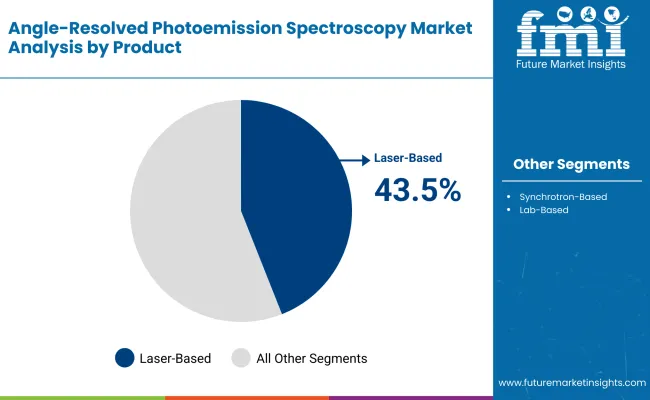
| Product | Market Value Share, 2025 |
|---|---|
| Laser-based ARPES Systems | 43.5% |
| Synchrotron-based ARPES Systems | 27.3% |
| Lab-based ARPES Systems | 29.2% |
Laser-based ARPES Systems are projected to lead the product category with a 43.5% market share in 2025 and are expected to maintain this position due to their ability to deliver ultrahigh energy and momentum resolution in compact, lab-scale environments. Unlike synchrotron-based setups, laser-based systems offer femtosecond temporal resolution and exceptional photon flux at narrow bandwidthsallowing researchers to resolve low-energy excitations and subtle quasiparticle dynamics with unprecedented precision.
Recent advances in 6 eV to 11 eV laser sources, combined with innovations in monochromator design and thermal stabilization, have enabled these systems to operate near the theoretical limits of resolution.
A key factor behind their dominance is their growing presence in university labs and national research institutes. With commercial vendors now offering turnkey systems that require minimal user calibration, laser-based ARPES is becoming more accessible to non-synchrotron-equipped facilities. Their relatively lower footprint and infrastructure demands further position them as the go-to platform for precision spectroscopy in condensed matter physics.
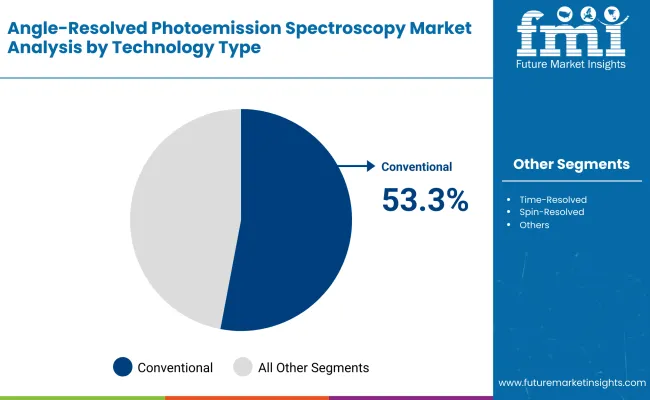
| Technology Type | Market Value Share, 2025 |
|---|---|
| Conventional ARPES | 53.33% |
| Time-Resolved ARPES ( trARPES) | 21.60% |
| Spin-Resolved ARPES (SARPES) | 15.33% |
| Others | 9.75% |
Conventional ARPES continues to dominate the technology landscape, accounting for over half of total demand in 2025. This technique remains the foundation of electronic structure research due to its proven ability to map valence band dispersions, Fermi surfaces, and quasiparticle interactions with high energy and angular resolution. As an essential characterization method in surface and condensed matter physics, conventional ARPES offers unmatched insight into materials where electron correlation and topological features are central to functional behavior.
Recent improvements in detector sensitivity, sample cooling techniques, and vacuum stability have further enhanced the resolution and usability of conventional ARPES, especially in lab-based systems. Moreover, academic curricula and national lab research programs continue to prioritize conventional ARPES as a primary training and discovery tool, ensuring a sustained pipeline of skilled users and stable funding.
While advanced methods such as trARPES and SARPES are gaining ground in niche applications, conventional ARPES remains the mainstay of the global market, largely due to its versatility, accessibility, and broad compatibility with a wide range of experimental conditions and material classes.
The adoption of ARPES is accelerating across multiple research disciplines as experimental and computational advancements converge to deepen the understanding of electronic structures in complex materials. While momentum is strong, the market also faces structural limitations unique to the technique’s complexity and infrastructure needs.
Growing Role in Quantum and Electronic Materials Research
ARPES is now essential in the study of quantum materials, superconductors, and 2D systems. It directly reveals how electrons behave at the surface and within bulk statessomething conventional tools cannot do. Research labs and universities are using it to validate theories and discover new phases of matter. As quantum computing and spintronics advance, ARPES is becoming a standard tool in material validation workflows.
Infrastructure Demands and Technical Complexity Limit Widespread ARPES Adoption
ARPES requires ultrahigh vacuum, clean surfaces, and cryogenic coolingmaking setup and maintenance costly and complex. Sample degradation and charging effects can distort results, limiting the range of usable materials. Operators need deep knowledge of surface science, vacuum technology, and data analysis, which creates a training bottleneck. These factors prevent widespread adoption in routine testing environments or industrial R&D. Without proper facilities, even powerful systems remain underutilized. This remains a key restraint in expanding beyond specialized research institutes.
Shift Toward Compact and Lab-Ready ARPES Systems
The ARPES market is expanding as more labs move away from reliance on synchrotron facilities. Manufacturers now offer compact, turnkey ARPES systems that fit into standard research labs. These systems combine high energy resolution with simple interfaces, making them usable even by first-time operators. Improved laser sources, cryo-stages, and electron analyzers allow labs to perform high-end spectroscopy without needing large infrastructure. Countries investing in research independence are equipping national universities with in-house ARPES setups, expanding the market beyond traditional power users.
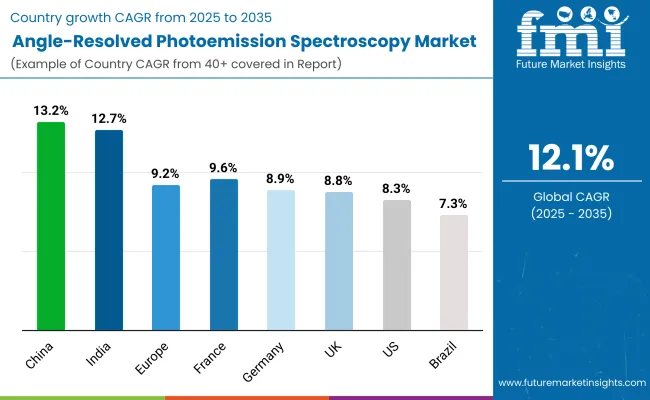
| Countries | CAGR |
|---|---|
| USA | 8.3% |
| Brazil | 7.3% |
| China | 13.2% |
| India | 12.7% |
| Europe | 9.2% |
| Germany | 8.9% |
| France | 9.6% |
| UK | 8.8% |
The adoption of Angle-Resolved Photoemission Spectroscopy (ARPES) systems exhibit distinct variations across different regions, influenced by the maturity of research infrastructure, government investment in advanced material sciences, and specialized application demand.
In the United States, the ARPES market is characterized by strong growth driven by a robust ecosystem of academic and government-funded research institutions, as well as leading technology companies focusing on semiconductor and quantum materials. The availability of advanced synchrotron radiation facilities and laser-based ARPES systems supports cutting-edge investigations, resulting in widespread adoption.
The presence of specialized research centers and continuous investments in next-generation electronic materials propels demand for ARPES systems, particularly in areas like quantum computing and novel semiconductor development. The market here is projected to grow at a CAGR of 8.3%.
In Europe, countries such as Germany, France, and the UK lead the ARPES landscape with growing emphasis on integrating ARPES techniques within national research initiatives and material innovation frameworks. Government-backed research programs and large-scale synchrotron facilities have simplified extensive collaboration, enabling use of time-resolved and spin-resolved ARPES technologies for advanced studies in topological insulators, superconductors, and spintronics.
Regulatory support for large scientific infrastructures and strategic funding foster sustained market growth, though adoption remains cautiously progressive as new ARPES modalities continue to prove their utility in real-world applications. The market in Germany is expected to expand at a CAGR of 8.9%, France at 9.6%, and the UK at 8.8%.
Overall, the ARPES market globally reflects a strategic blend of technological advancement, research priority alignment, and institutional investment, which altogether govern the pace and scale of adoption in different countries. This dynamic interplay underscores the central role that regional research policies, infrastructure availability, and scientific expertise play in shaping the trajectory of this highly specialized spectroscopy market.
| Year | USA Angle-Resolved Photoemission Spectroscopy Market (USD Million) |
|---|---|
| 2025 | 26.4 |
| 2026 | 28.5 |
| 2027 | 30.8 |
| 2028 | 33.3 |
| 2029 | 36.1 |
| 2030 | 39.0 |
| 2031 | 42.3 |
| 2032 | 45.8 |
| 2033 | 49.6 |
| 2034 | 53.9 |
| 2035 | 58.6 |
The angle-resolved photoemission spectroscopy market in the United States has been forecasted to expand at a CAGR of 8.3% between 2025 and 2035. The United States remains the most mature and research-intensive market for ARPES, with long-standing integration into physics, materials science, and semiconductor characterization programs.
Universities such as MIT, Stanford, and UC Berkeley, alongside institutions like the Department of Energy’s National Labs, have been pivotal in setting global benchmarks for ARPES applications in topological materials and many-body physics. The USA also hosts several of the world’s most advanced synchrotron and free-electron laser facilities, providing routine access to high-resolution, beamline-specific ARPES.
The angle-resolved photoemission spectroscopy market in India is expected to grow at a CAGR of 12.7% between 2025 and 2035, with growing academic interest but limited infrastructure outside top-tier institutions.
Premier research bodies like the Indian Institute of Science (IISc), Tata Institute of Fundamental Research (TIFR), and IIT Bombay have established capabilities in surface science and are leading the adoption of ARPES in condensed matter physics and quantum material studies. However, the number of operational ARPES systems remains low, primarily due to high setup costs, limited cryogenic and UHV expertise, and reliance on central government grants.
China’s angle-resolved photoemission spectroscopy market is projected to expand at a CAGR of 13.2% from 2025 to 2035. China’s ARPES market is expanding rapidly, driven by its strong investment in quantum materials, heavy-fermion systems, and two-dimensional heterostructures.
Top institutions such as Tsinghua University, Peking University, and the Institute of Physics (Chinese Academy of Sciences) have advanced ARPES facilities and regularly publish in high-impact journals using the technique. Several national laboratories have installed high-resolution, spin-resolved, and time-resolved ARPES systems, often developed in collaboration with domestic equipment manufacturers.
The angle-resolved photoemission spectroscopy market in the United Kingdom is projected to grow at a CAGR of 8.8% between 2025 and 2035.The ARPES market in the United Kingdom is backed by strong public investment in quantum materials and next-generation electronics, with leading institutions such as the University of Oxford, University of Cambridge, and University of St Andrews integrating ARPES into their condensed matter research workflows. The country benefits from centralized beamline access through the Diamond Light Source, where several ARPES endstations support national and EU-wide collaborations.
In recent years, the UK has seen a rise in lab-based ARPES installations driven by EPSRC-funded capital grants and participation in pan-European quantum research initiatives. These systems are increasingly being used in conjunction with low-temperature transport and angle-integrated spectroscopy experiments, enabling more holistic analysis of quantum and spintronic materials.
The angle-resolved photoemission spectroscopy market in Germany is anticipated to grow at a CAGR of 8.9% between 2025 and 2035. Germany is positioning itself as a key industrial hub for high-precision ARPES applications, particularly in electronic materials, spintronics, and applied surface engineering.
While academic research remains strong, much of the current growth is fueled by collaborations between federal labs, semiconductor companies, and precision equipment manufacturers. German firms are playing a strategic role in developing ARPES subsystemsincluding electron analyzers, UHV manipulators, and high-stability cryostats, which are now being integrated into international system builds.
| Europe Countries | 2025 |
|---|---|
| Germany | 26.3% |
| UK | 16.2% |
| France | 14.1% |
| Italy | 11.1% |
| Spain | 8.1% |
| BENELUX | 9.1% |
| Nordic Countries | 10.1% |
| Rest of Western Europe | 5.1% |
| Europe Countries | 2035 |
|---|---|
| Germany | 27.4% |
| UK | 15.2% |
| France | 13.1% |
| Italy | 10.1% |
| Spain | 6.1% |
| BENELUX | 10.1% |
| Nordic Countries | 8.1% |
| Rest of Western Europe | 11.1% |
| Product | Market Value Share, 2025 |
|---|---|
| Laser-based ARPES Systems | 45.5% |
| Synchrotron-based ARPES Systems | 28.3% |
| Lab-based ARPES Systems | 26.2% |
The angle-resolved photoemission spectroscopy market in Japan has been projected to reach USD 6.9 million by 2025. Laser-based ARPES Systemswill lead the product landscape with an 45.5% share, followed bysynchrotron-based APRES system 28.3%. The ARPES market in Japan is shaped by a long-standing research tradition in condensed matter physics and advanced surface science.
Japan’s national universities and research institutes, such as the University of Tokyo, RIKEN, and Osaka University, have made ARPES central to their investigation of 2D materials, superconductors, and topological systems. Many institutions operate both synchrotron-based ARPES and in-lab laser setups, allowing diverse experimentation ranging from fundamental band studies to time-resolved ultrafast dynamics.
| Technology Type | Market Value Share, 2025 |
|---|---|
| Conventional ARPES | 54.3% |
| Time-Resolved ARPES ( trARPES ) | 22.6% |
| Spin-Resolved ARPES (SARPES) | 17.3% |
| Others | 5.8% |
The angle-resolved photoemission spectroscopy market in South Korea has been projected to reach USD 2.0 million in 2025. Conventional ARPESare expected to lead technology type with an 54.3%. South Korea’s ARPES market is evolving from fundamental physics toward semiconductor-driven and industrial-grade applications.
National institutes such as the Korea Institute of Science and Technology (KIST) and POSTECH are leading advanced ARPES research focused on thin films, oxide interfaces, and quantum well structures. However, a key differentiator for South Korea is its early-stage application of ARPES in semiconductor R&D and materials engineering, particularly in defect analysis and energy band alignment studies relevant to chip fabrication.
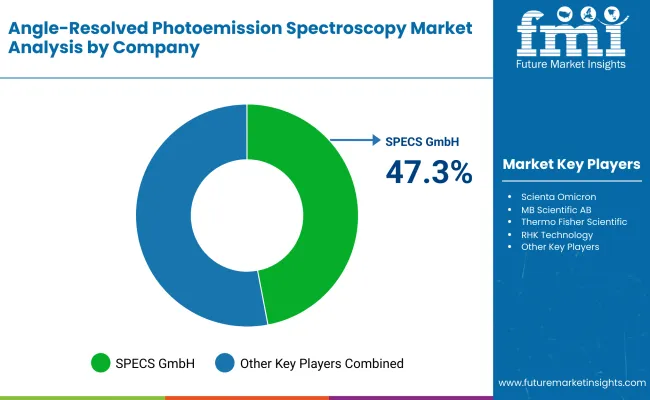
The ARPES market is moderately concentrated, with a blend of global leaders, mid-sized innovators, and domain-specific specialists shaping the competitive landscape. SPECS GmbH holds a leading position, driven by its deep specialization in ultra-high vacuum surface analysis systems. The company’s integrated platform approach which includes custom cryostats, hemispherical analyzers, and proprietary control softwarepositions it as the preferred vendor for high-resolution, spin- and time-resolved ARPES studies in quantum materials and 2D systems.
Established mid-tier players such as Scienta Omicron, MB Scientific AB, and Thermo Fisher Scientific address distinct segments of the ARPES ecosystem. Scienta Omicron is prominent in beamline-integrated systems and maintains strong partnerships with major synchrotron facilities, delivering high-throughput solutions for collaborative research. MB Scientific AB specializes in precision electron optics and monochromators, serving elite academic and national labs focused on condensed matter physics. Thermo Fisher, while broader in scientific instrumentation, is gaining traction in surface science platforms, integrating ARPES capabilities into multi-modal material characterization workflows.
Niche-focused manufacturers are emerging with compact, application-driven systems tailored for university and national lab installations in emerging regions. These vendors differentiate through customization, modular design, and localized support, enabling decentralized research capabilities without reliance on synchrotron access.
Competitive differentiation in the ARPES market is increasingly defined by the depth of ecosystem integrationcombining hardware with AI-assisted spectral analysis, real-time visualization, and interoperability with adjacent techniques like STM and LEED.
Key Developments in Angle-Resolved Photoemission Spectroscopy Market
| Item | Value |
|---|---|
| Quantitative Units | USD 93.3 million |
| Product | Laser-based ARPES Systems, Synchrotron-based ARPES Systems and Lab-based ARPES Systems |
| Technology Type | Conventional ARPES, Time-Resolved ARPES ( trARPES), Spin-Resolved ARPES (SARPES) and Others |
| End User | Academic & Research Institutes, Synchrotron Facilities, Semiconductor & Electronics Companies, Quantum Computing Startups & Labs and Government Laboratories |
| Regions Covered | North America, Latin America, Western Europe, Eastern Europe, East Asia, South Asia & Pacific, Middle East & Africa |
| Countries Covered | USA, Brazil, China, India, Europe, Germany, France and UK |
| Key Companies Profiled | SPECS GmbH, Scienta Omicron, MB Scientific AB, Thermo Fisher Scientific, RHK Technology and Others |
The global Angle-Resolved Photoemission Spectroscopy Market is estimated to be valued at USD 93.3 million in 2025.
The market size for the Angle-Resolved Photoemission Spectroscopy Market is projected to reach approximately USD 292.5 million by 2035.
The Angle-Resolved Photoemission Spectroscopy Market is expected to grow at a CAGR of 12.1% between 2025 and 2035.
The key product formats in the Angle-Resolved Photoemission Spectroscopy Market include Laser-based ARPES Systems, Synchrotron-based ARPES Systems and Lab-based ARPES Systems.
In terms of technology, Conventional ARPES segment is projected to command the highest share at 53.3% in the Angle-Resolved Photoemission Spectroscopy Market in 2025.






Our Research Products

The "Full Research Suite" delivers actionable market intel, deep dives on markets or technologies, so clients act faster, cut risk, and unlock growth.

The Leaderboard benchmarks and ranks top vendors, classifying them as Established Leaders, Leading Challengers, or Disruptors & Challengers.

Locates where complements amplify value and substitutes erode it, forecasting net impact by horizon

We deliver granular, decision-grade intel: market sizing, 5-year forecasts, pricing, adoption, usage, revenue, and operational KPIs—plus competitor tracking, regulation, and value chains—across 60 countries broadly.

Spot the shifts before they hit your P&L. We track inflection points, adoption curves, pricing moves, and ecosystem plays to show where demand is heading, why it is changing, and what to do next across high-growth markets and disruptive tech

Real-time reads of user behavior. We track shifting priorities, perceptions of today’s and next-gen services, and provider experience, then pace how fast tech moves from trial to adoption, blending buyer, consumer, and channel inputs with social signals (#WhySwitch, #UX).

Partner with our analyst team to build a custom report designed around your business priorities. From analysing market trends to assessing competitors or crafting bespoke datasets, we tailor insights to your needs.
Supplier Intelligence
Discovery & Profiling
Capacity & Footprint
Performance & Risk
Compliance & Governance
Commercial Readiness
Who Supplies Whom
Scorecards & Shortlists
Playbooks & Docs
Category Intelligence
Definition & Scope
Demand & Use Cases
Cost Drivers
Market Structure
Supply Chain Map
Trade & Policy
Operating Norms
Deliverables
Buyer Intelligence
Account Basics
Spend & Scope
Procurement Model
Vendor Requirements
Terms & Policies
Entry Strategy
Pain Points & Triggers
Outputs
Pricing Analysis
Benchmarks
Trends
Should-Cost
Indexation
Landed Cost
Commercial Terms
Deliverables
Brand Analysis
Positioning & Value Prop
Share & Presence
Customer Evidence
Go-to-Market
Digital & Reputation
Compliance & Trust
KPIs & Gaps
Outputs
Full Research Suite comprises of:
Market outlook & trends analysis
Interviews & case studies
Strategic recommendations
Vendor profiles & capabilities analysis
5-year forecasts
8 regions and 60+ country-level data splits
Market segment data splits
12 months of continuous data updates
DELIVERED AS:
PDF EXCEL ONLINE
Spectroscopy Equipment and Supplies Market Growth – Trends & Forecast 2018-2027
Spectroscopy Intravascular Imaging System Market
IR Spectroscopy Market Analysis - Growth & Forecast 2025 to 2035
THz Spectroscopy Kit Market Size and Share Forecast Outlook 2025 to 2035
Atomic Spectroscopy Market Size and Share Forecast Outlook 2025 to 2035
Process Spectroscopy Market Analysis - Size, Share, and Forecast Outlook 2025 to 2035
Molecular Spectroscopy Market Insights - Growth & Forecast 2025 to 2035
Fluorescence Spectroscopy Market Size and Share Forecast Outlook 2025 to 2035
Bioimpedance Spectroscopy Market – Trends & Forecast 2025 to 2035
Optical Emission Spectroscopy Market Report – Trends 2019-2027
Atomic Absorption Spectroscopy Market Size and Share Forecast Outlook 2025 to 2035
X-ray Photoelectron Spectroscopy Market Insights - Growth & Forecast 2024 to 2034
Microfluidic Modulation Spectroscopy Market Size and Share Forecast Outlook 2025 to 2035

Thank you!
You will receive an email from our Business Development Manager. Please be sure to check your SPAM/JUNK folder too.
Chat With
MaRIA